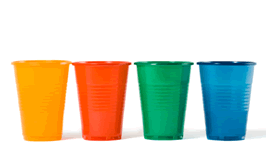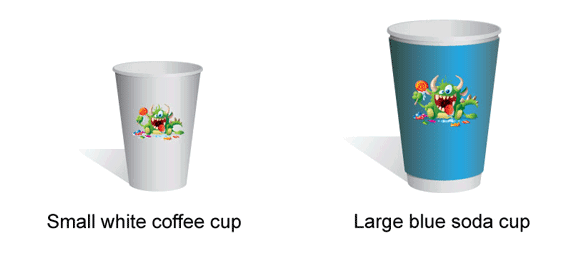How To Describe Items Or Products In Inventory
A Rose by Any Other Name Is Still a Rose, But You Won’t Be Able to Find It.
NOTE: In this section, we assume that you already have a list (or partial list) of the items that you stock. And we make these recommendations here so that you can evaluate the quality of your item descriptions as they currently exist and make changes now, before you move on. If you DO NOT have a list of items already, or you have a lot of items missing from your list, you may want to create your item description list as you perform your starting counts as described on the How to Count Your Inventory Items page. Either way, you should read this section to familiarize yourself with good practices for creating item descriptions.

How to Create Good Inventory Item Descriptions
Tips on Creating Good Item Descriptions
- Most important: Inventory item descriptions should begin with a noun (what the item is) followed by the adjectives that describe the item (in descending order of the adjective’s importance). This is so important that we offer a much more detailed and illustrated example below!.
- Inventory item descriptions should be unique.
- Avoid loading inventory item descriptions with more information than absolutely necessary. Information such as vendor names, manufacturer, country of origin, expiration dates, and so on belongs in the “item details” or “transaction details” areas where it can be used more effectively.
How to Create Good Inventory Item Descriptions
The single biggest mistake people make when describing items is to describe them in the same way that they talk about them.
Consider below example:

We all describe things this way, and you will certainly refer to them this way in your day-to-day operations, but there’s a big difference in the way we talk about things and the way they get stored and presented in a system or database. You will often find yourself looking at printed lists of your items or lists on a computer screen. And these lists will usually be arranged ALPHABETICALLY.
Consider these two description lists:
List – A
| Large blue soda cup |
| Large blue soda lid |
| Large brown coffee cup |
| Large brown coffee lid |
| Large brown coffee sleeve |
| Large brown coffee stirrer |
| Large white coffee cup |
| Large white coffee lid |
| Large white coffee sleeve |
| Large white coffee stirrer |
| Large yellow soda cup |
| Large yellow soda lid |
| Medium blue soda cup |
| Medium blue soda lid |
| Medium brown coffee cup |
| Medium brown coffee lid |
| Medium brown coffee sleeve |
| Medium brown coffee stirrer |
| Medium white coffee cup |
| Medium white coffee lid |
| Medium white coffee sleeve |
| Medium white coffee stirrer |
| Medium yellow soda cup |
| Medium yellow soda lid |
| Small blue soda cup |
| Small blue soda lid |
| Small brown coffee cup |
| Small brown coffee lid |
| Small brown coffee sleeve |
| Small brown coffee stirrer |
| Small white coffee cup |
| Small white coffee lid |
| Small white coffee sleeve |
| Small white coffee stirrer |
| Small yellow soda cup |
| Small yellow soda lid |
List – B
| Cup, coffee, large, brown |
| Cup, coffee, large, white |
| Cup, coffee, medium, brown |
| Cup, coffee, medium, white |
| Cup, coffee, small, brown |
| Cup, coffee, small, white |
| Cup, soda, large, blue |
| Cup, soda, large, yellow |
| Cup, soda, medium, blue |
| Cup, soda, medium, yellow |
| Cup, soda, small, blue |
| Cup, soda, small, yellow |
| Lid, coffee, large, brown |
| Lid, coffee, large, white |
| Lid, coffee, medium, brown |
| Lid, coffee, medium, white |
| Lid, coffee, small, brown |
| Lid, coffee, small, white |
| Lid, soda, large, blue |
| Lid, soda, large, yellow |
| Lid, soda, medium, blue |
| Lid, soda, medium, yellow |
| Lid, soda, small, blue |
| Lid, soda, small, yellow |
| Sleeve, coffee, large, brown |
| Sleeve, coffee, large, white |
| Sleeve, coffee, medium, brown |
| Sleeve, coffee, medium, white |
| Sleeve, coffee, small, brown |
| Sleeve, coffee, small, white |
| Stirrer, coffee, large, brown |
| Stirrer, coffee, large, white |
| Stirrer, coffee, medium, brown |
| Stirrer, coffee, medium, white |
| Stirrer, coffee, small, brown |
| Stirrer, coffee, small, white |
A good item description makes the process fast and efficient. Finding one item on either list is easy, but what about looking for groups of items? More often than not, you’re going to need to view your items by their type and not their size or color. Anything can be small, large, blue, red, etc. But a “cup” is a “cup” and a “lid” is a “lid”. List A is great if you need to locate all of the large things in your facility, but that request will happen about never. “Quick, get me all of the large stuff!” On the other hand, List B is great if you need to locate all of your cups, and that mission is much more likely.
List A makes it easy to find adjectives, while List B makes it easy to find things. And your inventory is a collection of things, not adjectives. Using the description format we recommend, you’ll be able to view similar items at a glance and spare yourself from hunting through your items list. What kind of information should be contained in your item descriptions? A good item description includes anything required to uniquely identify an item and no more. For instance, if the brand name of an item is important, then it should be in the description because it’s different from a similar item of a different brand. But if the brand doesn’t matter to you, then you should leave it out of the description. Also, don’t put information like the location, expiration date, or other temporal qualities into the description. These things are better tracked in “Custom Transaction Fields”. For more on inventory management, see Getting Started – Create, Configure, and Manage your Inventory